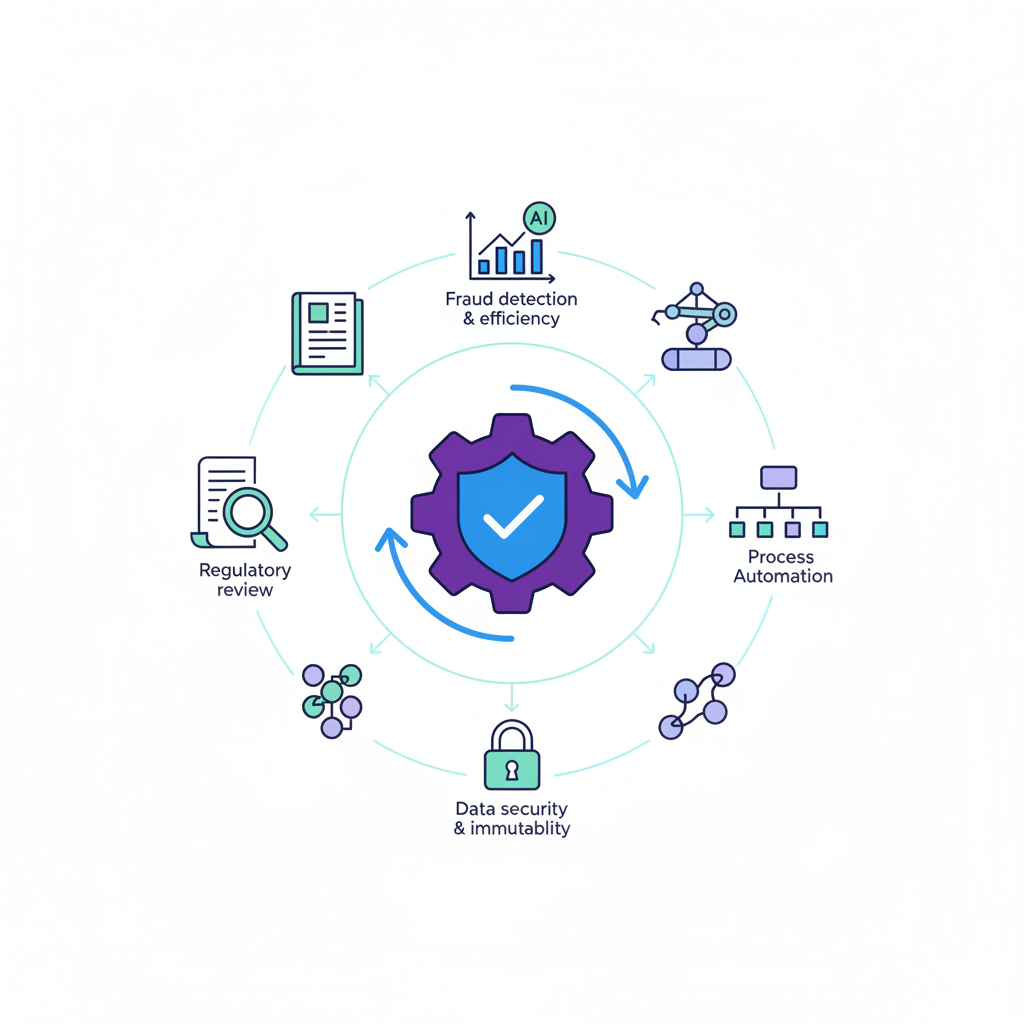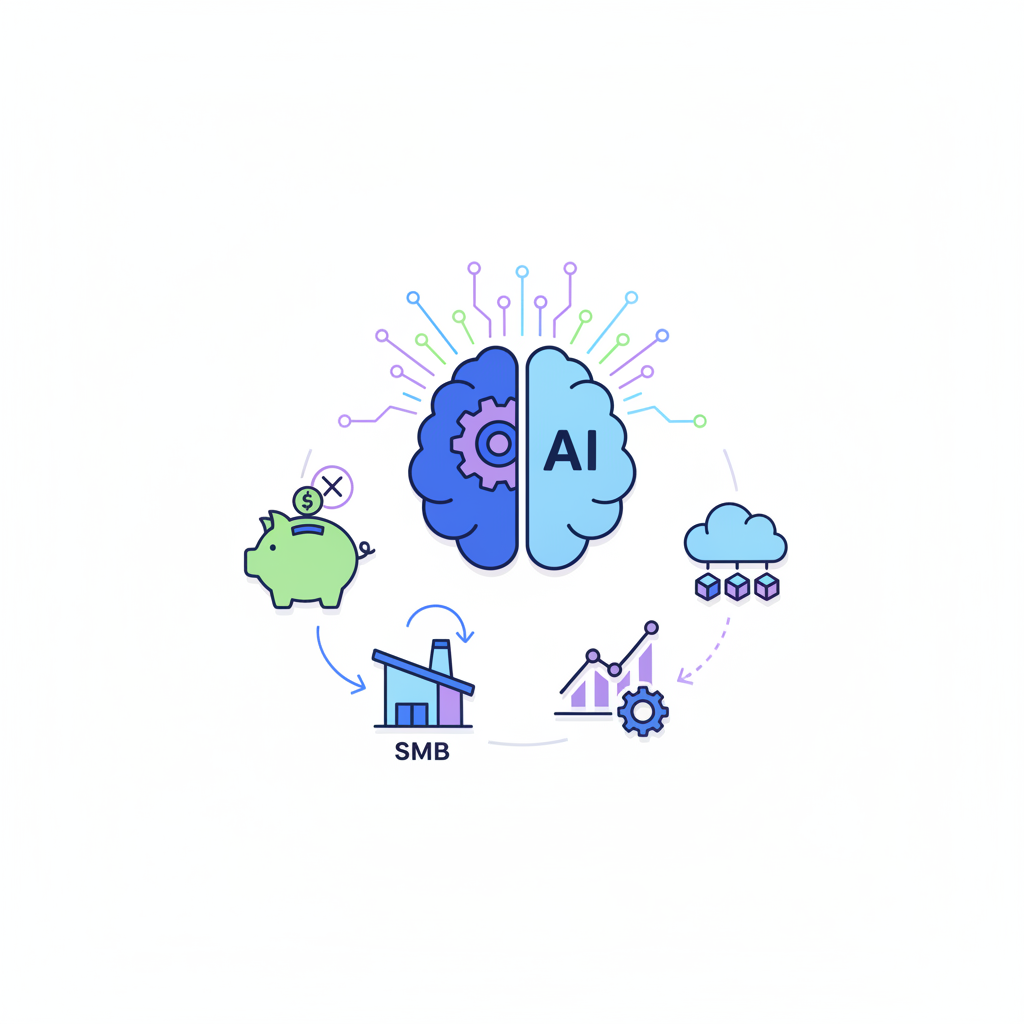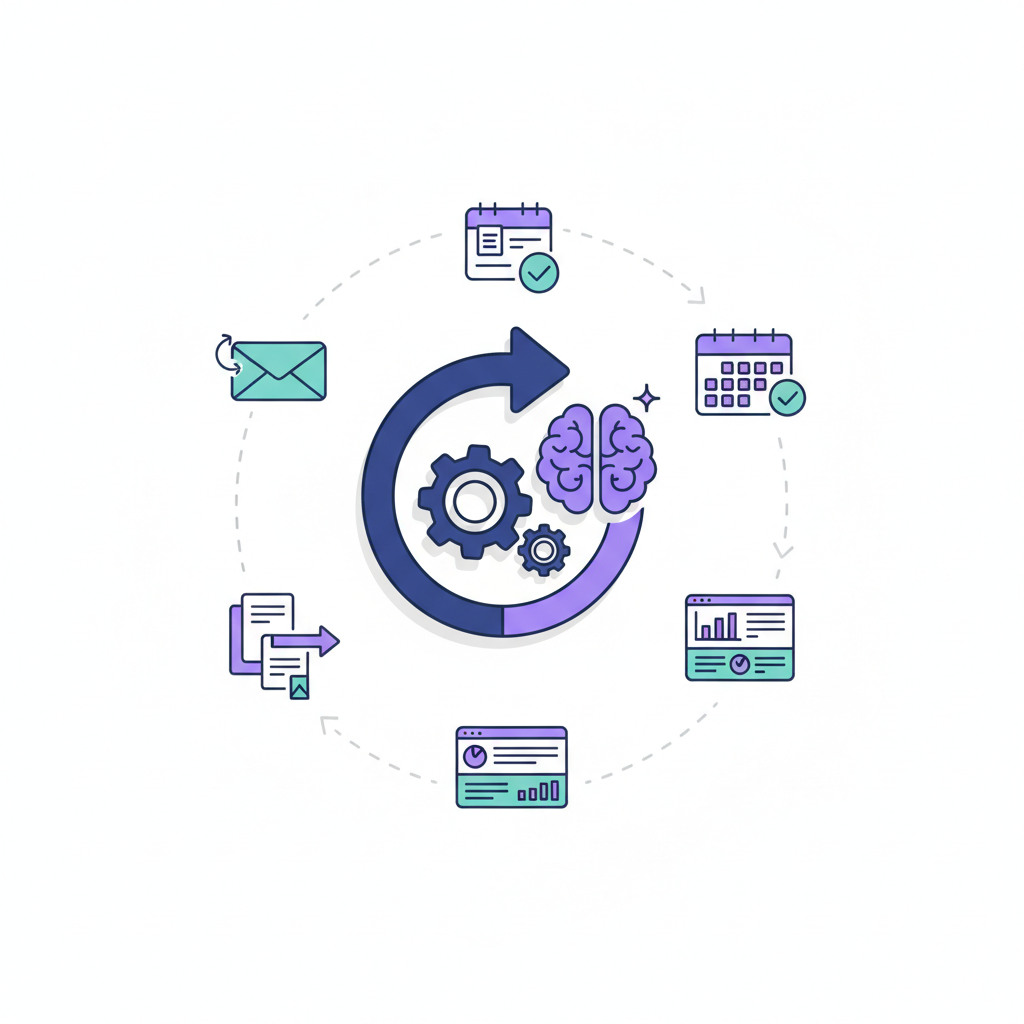Top 10 AI Tools for Inventory Management
Discover the top 10 AI tools for inventory management in 2025, including IBM Sterling, SAP IBP, Oracle SCM, and Blue Yonder. Optimise demand forecasting, reduce costs, and enhance efficiency with AI-driven solutions for modern supply chains.
Revolutionizing Stock: The Rise of AI in Inventory Management
The modern supply chain is a labyrinth of interconnected processes, constantly challenged by fluctuating demand, global disruptions, and the relentless pressure for efficiency. Businesses today grapple with immense inventory challenges, from managing vast product catalogs across multiple locations to predicting customer behavior with pinpoint accuracy. Traditional inventory methods, often reliant on historical averages and manual adjustments, simply struggle to keep pace with this demand volatility, leading to costly waste, stockouts, and widespread inefficiencies. This is where artificial intelligence (AI) emerges as a transformative force.
Can AI do inventory management? Absolutely, and with unprecedented precision. AI is a game-changer, offering sophisticated solutions for prediction, optimization, and automation that far surpass human capabilities and conventional software limitations. By leveraging advanced algorithms and machine learning, AI inventory management systems can analyze colossal datasets, identify subtle patterns, and make proactive decisions that streamline operations. In this comprehensive guide, readers will learn how AI works in inventory, its myriad benefits, a detailed look at the top AI tools for inventory management, a practical selection guide, and insights into future trends. Our thesis is clear: embracing the best AI tools is no longer an option but a strategic imperative to transform your inventory operations and achieve truly efficient inventory management within your supply chain.
The Power of AI in Modern Inventory Management
What is AI Inventory Management?
At its core, AI inventory management refers to the application of artificial intelligence technologies, primarily machine learning (ML) and predictive analytics, to automate, optimize, and enhance various aspects of inventory control and planning. It moves beyond the reactive nature of traditional inventory planning software, which often relies on fixed rules and historical averages, by enabling systems to learn from data, adapt to changing conditions, and make intelligent, data-driven decisions. This involves algorithms that can process vast amounts of information—from sales history and seasonal trends to external factors like weather and economic indicators—to forecast future demand, optimize stock levels, and automate replenishment processes. Essentially, AI transforms inventory from a static ledger into a dynamic, intelligent system capable of continuous improvement.
How AI Transforms Inventory Processes
The integration of AI fundamentally reshapes how businesses approach inventory.
- Enhanced Demand Forecasting: AI excels at forecasting and optimization inventory. Unlike traditional methods, AI models can analyze historical sales data, promotional calendars, market trends, competitor activities, and even external factors like social media sentiment or weather patterns. Machine learning algorithms identify complex, non-linear relationships in this data, leading to significantly more accurate demand predictions, minimizing both overstocking and stockouts.
- Dynamic Stock Optimization: AI-powered systems continuously monitor inventory levels in real-time. They dynamically calculate optimal safety stock levels, reorder points, and order quantities based on predicted demand, lead times, and desired service levels. This ensures that capital isn't tied up in excess inventory while still meeting customer needs.
- Automated Reordering and Replenishment: With precise forecasts and optimized stock levels, AI can automate the entire reordering and replenishment process. The system can generate purchase orders, trigger transfers between warehouses, and even negotiate with suppliers, minimizing human error and freeing up staff for more strategic tasks.
- Predictive Maintenance for Warehouse Equipment: Beyond stock, AI can monitor the performance of warehouse equipment (e.g., forklifts, conveyor belts). By analyzing sensor data, it can predict potential equipment failures before they occur, scheduling maintenance proactively and preventing costly operational disruptions.
Optimizing with the 80/20 Rule: An AI Approach
The Pareto Principle, or the 80/20 rule, states that roughly 80% of effects come from 20% of causes. In inventory, this often means 20% of your items account for 80% of your sales or profit (A-category items), while the remaining 80% (B and C categories) contribute less. AI takes this principle to a new level.
Traditional inventory planning often struggles to apply the 80/20 rule effectively across a large SKU base. AI, however, can swiftly identify and categorize items based on their value, velocity, and criticality. For high-value (A-category) items, AI enables hyper-precise management, focusing on minimizing stockouts and optimizing inventory turns to maximize profitability. For B and C categories, AI can automate replenishment with less frequent reviews, reducing the administrative burden while still ensuring adequate stock. This intelligent prioritization allows businesses to allocate resources where they matter most, significantly optimizing inventory turns and reducing carrying costs across all categories.
Core Benefits and ROI of AI Solutions
Investing in AI inventory management yields substantial returns:
- Improved Accuracy & Reduced Errors: AI processes vast datasets with unparalleled accuracy, leading to data-driven decisions that minimize human error in forecasting, ordering, and stock management.
- Optimized Stock Levels & Reduced Holding Costs: By precisely predicting demand and optimizing reorder points, AI minimizes overstocking, reduces obsolescence, and significantly lowers inventory holding costs.
- Enhanced Efficiency & Productivity: Automation of routine tasks like reordering, data entry, and reporting frees up staff to focus on strategic initiatives, boosting overall operational efficiency and productivity.
- Better Decision-Making: AI provides actionable insights from complex data, empowering managers with a clearer understanding of inventory performance, potential risks, and opportunities for improvement, leading to more informed and strategic decisions.
Top 10 AI Tools Revolutionizing Inventory Management
The market for AI inventory management systems is rapidly expanding, offering sophisticated solutions for businesses of all sizes and industries. Our selection criteria for these top tools focused on their core AI capabilities (machine learning, predictive analytics, automation), integration potential, scalability, user-friendliness, and proven impact on inventory optimization. These tools represent the best inventory planning software available today, setting the standard for inventory planning software 2025 and beyond.
1. IBM Sterling Supply Chain Insights
Key Features & AI Capabilities of IBM Sterling Supply Chain Insights
IBM Sterling leverages advanced AI and machine learning to provide end-to-end visibility and predictive insights across the entire supply chain, including inventory. Its AI capabilities focus on identifying anomalies, predicting disruptions, and recommending actions to optimize stock levels and fulfillment. It uses machine learning for demand forecasting, considering a multitude of internal and external factors, and offers prescriptive analytics to guide inventory decisions.
Pros and Cons of IBM Sterling Supply Chain Insights
Pros: Comprehensive supply chain visibility, robust AI for predictive and prescriptive analytics, strong integration capabilities with existing ERPs, enterprise-grade security and reliability.
Cons: Can be complex to implement, typically geared towards larger enterprises, higher cost of ownership.
Best For: IBM Sterling Supply Chain Insights Use Cases
Large enterprises and complex global supply chains requiring deep insights, risk mitigation, and sophisticated AI for warehouse management and inventory optimization across multiple tiers.
2. SAP Integrated Business Planning (IBP)
Key Features & AI Capabilities of SAP Integrated Business Planning (IBP)
SAP IBP offers a suite of planning applications that utilize advanced analytics and machine learning for demand sensing, inventory optimization, and supply planning. Its AI-driven algorithms analyze historical data, real-time sales, and market signals to generate highly accurate forecasts and recommend optimal inventory targets, balancing service levels with cost efficiency.
Pros and Cons of SAP Integrated Business Planning (IBP)
Pros: Seamless integration with other SAP modules (ERP), powerful forecasting and optimization engines, highly scalable, strong community and support.
Cons: Can be resource-intensive to implement and maintain, steep learning curve for new users, primarily targets SAP ecosystem users.
Best For: SAP Integrated Business Planning (IBP) Use Cases
Large and mid-sized businesses already using SAP ERP, particularly those in manufacturing, retail, and consumer goods, seeking an integrated, AI-powered planning solution.
3. Oracle Supply Chain Management (SCM) Cloud
Key Features & AI Capabilities of Oracle Supply Chain Management (SCM) Cloud
Oracle SCM Cloud integrates AI and machine learning across its modules, including inventory management, planning, and logistics. Its AI capabilities enable intelligent demand forecasting, automated replenishment, and optimized inventory positioning. It uses ML to detect patterns in demand, predict lead time variability, and suggest optimal safety stock levels to reduce carrying costs while maintaining service.
Pros and Cons of Oracle Supply Chain Management (SCM) Cloud
Pros: Comprehensive suite covering all SCM aspects, strong AI and analytics features, cloud-native architecture, good for global operations.
Cons: Can be costly, complex for smaller businesses, requires significant configuration.
Best For: Oracle Supply Chain Management (SCM) Cloud Use Cases
Mid-to-large enterprises looking for a holistic, cloud-based AI inventory management solution that integrates seamlessly with other Oracle applications.
4. Blue Yonder (formerly JDA Software)
Key Features & AI Capabilities of Blue Yonder
Blue Yonder is a leader in AI-driven supply chain and retail solutions. Its inventory optimization capabilities are powered by advanced machine learning algorithms that predict demand, optimize inventory levels across the network, and automate replenishment decisions. It focuses on delivering hyper-localized and personalized inventory strategies.
Pros and Cons of Blue Yonder
Pros: Deep industry expertise, highly sophisticated AI for demand forecasting and inventory optimization, strong track record in retail and manufacturing.
Cons: Can be expensive, implementation can be complex, best suited for larger organizations with significant inventory challenges.
Best For: Blue Yonder Use Cases
Large retailers, manufacturers, and logistics providers with complex, multi-echelon inventory networks seeking cutting-edge AI for warehouse management and supply chain planning.
5. EazyStock
Key Features & AI Capabilities of EazyStock
EazyStock is a cloud-based inventory optimization software that uses AI and machine learning to automate forecasting, optimize stock levels, and manage replenishment. It analyzes demand patterns, seasonality, and lead times to calculate optimal order quantities and reorder points, aiming to reduce working capital and improve service levels.
Pros and Cons of EazyStock
Pros: User-friendly interface, quick implementation, strong focus on inventory optimization, good for small to mid-sized businesses.
Cons: May lack some of the broader supply chain features of enterprise-level solutions, integration capabilities might be less extensive than larger platforms.
Best For: EazyStock Use Cases
Small to mid-sized businesses (SMBs) and distributors looking for a dedicated, easy-to-use inventory planning software with powerful AI-driven optimization capabilities.
6. Lokad
Key Features & AI Capabilities of Lokad
Lokad specializes in quantitative supply chain optimization, using probabilistic forecasting and advanced machine learning to address complex inventory challenges. Instead of single-point forecasts, Lokad provides probability distributions for future demand, allowing businesses to make more robust decisions under uncertainty. It optimizes stock levels to maximize profit rather than just minimizing costs.
Pros and Cons of Lokad
Pros: Unique probabilistic forecasting approach, highly customizable, strong focus on economic optimization, powerful for complex and intermittent demand.
Cons: Requires a good understanding of quantitative methods, not a full-suite ERP, may require more technical expertise for setup.
Best For: Lokad Use Cases
Businesses with highly variable or intermittent demand, e-commerce companies, and those seeking advanced quantitative optimization for inventory and pricing.
7. Netstock
Key Features & AI Capabilities of Netstock
Netstock is a cloud-based inventory management solution that leverages AI and machine learning to provide intelligent forecasting, inventory optimization, and purchasing recommendations. It integrates with various ERP systems to analyze sales data, predict future demand, and classify inventory to suggest optimal order quantities and reorder points, reducing stockouts and excess inventory.
Pros and Cons of Netstock
Pros: Easy integration with popular ERPs (e.g., SAP Business One, Acumatica), intuitive dashboards, clear actionable insights, good for SMBs.
Cons: Primarily focused on inventory optimization, may not offer broader supply chain planning features, some advanced customization might be limited.
Best For: Netstock Use Cases
Small to mid-sized businesses and distributors looking for an effective, AI-powered inventory planning software that integrates well with their existing ERP.
8. StockIQ
Key Features & AI Capabilities of StockIQ
StockIQ offers a comprehensive suite for demand forecasting, inventory planning, and replenishment, powered by advanced statistical and machine learning algorithms. It handles complex forecasting scenarios, optimizes safety stock, and provides robust reporting and analytics to improve inventory performance and reduce carrying costs.
Pros and Cons of StockIQ
Pros: Strong forecasting capabilities, robust reporting, good for multi-location inventory, flexible and scalable.
Cons: User interface might feel less modern compared to some cloud-native solutions, implementation can be involved.
Best For: StockIQ Use Cases
Mid-market distributors and manufacturers with complex inventory needs across multiple warehouses, seeking detailed forecasting and inventory optimization.
9. Invent Analytics
Key Features & AI Capabilities of Invent Analytics
Invent Analytics provides AI-powered retail and omnichannel inventory solutions. Their platform uses machine learning to optimize inventory decisions across all channels, from demand forecasting and pricing to markdown optimization and fulfillment. It focuses on maximizing profitability by predicting customer behavior and optimizing stock placement.
Pros and Cons of Invent Analytics
Pros: Specialized for retail and omnichannel, strong focus on profitability optimization, advanced analytics for pricing and promotions.
Cons: Niche focus might not suit all industries, potentially higher cost for specialized features.
Best For: Invent Analytics Use Cases
Retailers and e-commerce businesses with omnichannel operations looking for AI tools for inventory management that also integrate pricing and promotion strategies.
10. RELEX Solutions
Key Features & AI Capabilities of RELEX Solutions
RELEX Solutions offers an integrated retail planning platform that uses AI and machine learning for demand forecasting, inventory optimization, space planning, and workforce scheduling. Its AI engine adapts to changes in demand, seasonality, and promotions, providing highly accurate forecasts and optimizing inventory levels across the entire supply chain, from distribution centers to stores.
Pros and Cons of RELEX Solutions
Pros: Comprehensive retail planning suite, powerful AI for forecasting and optimization, highly scalable, strong customer success stories.
Cons: Primarily focused on retail and consumer goods, can be a significant investment, implementation requires careful planning.
Best For: RELEX Solutions Use Cases
Large retailers and consumer goods companies seeking an integrated, AI-driven platform for end-to-end retail planning, including robust AI for warehouse management and store-level inventory.
Table: Comparison of Top AI Inventory Tools
| Tool Name | Key AI Focus | Pricing Model | Target Business Size | Unique AI Feature |
|---|---|---|---|---|
| IBM Sterling Supply Chain Insights | Predictive & Prescriptive Analytics, Visibility | Subscription | Enterprise | End-to-end supply chain risk prediction |
| SAP Integrated Business Planning (IBP) | Demand Sensing, Inventory Optimization | Subscription | Mid-Large Enterprise | Integrated planning across SAP ecosystem |
| Oracle SCM Cloud | Intelligent Forecasting, Automated Replenishment | Subscription | Mid-Large Enterprise | Holistic SCM suite with embedded AI |
| Blue Yonder | Hyper-localized Demand & Inventory Optimization | Subscription | Large Enterprise | Deep industry expertise, personalized strategies |
| EazyStock | Automated Forecasting & Stock Optimization | Subscription | SMB, Mid-Market | Quick implementation, user-friendly for SMBs |
| Lokad | Probabilistic Forecasting, Economic Optimization | Subscription | Mid-Large Enterprise | Focus on profit maximization, not just cost reduction |
| Netstock | Intelligent Forecasting, ERP Integration | Subscription | SMB, Mid-Market | Seamless integration with popular ERPs |
| StockIQ | Advanced Forecasting, Multi-Location Planning | Subscription | Mid-Market | Robust reporting for complex inventory scenarios |
| Invent Analytics | Omnichannel Inventory, Profit Optimization | Subscription | Retail, E-commerce | AI-driven pricing and promotion integration |
| RELEX Solutions | Integrated Retail Planning, Demand Sensing | Subscription | Large Retail | End-to-end retail planning, store-level optimization |
Selecting the Right AI Inventory Solution for Your Business
Choosing the best inventory planning software requires a strategic approach, aligning the capabilities of AI tools with your specific operational needs and business goals. This decision can significantly impact your efficiency, profitability, and competitive edge.
Assessing Your Unique Inventory Needs
Before diving into specific tools, a thorough self-assessment is crucial.
- Industry-specific requirements: Do you operate in retail, manufacturing, e-commerce, or distribution? Each industry has unique inventory dynamics, such as perishable goods, complex BOMs, or high-volume, fast-moving consumer goods. Ensure the solution understands these nuances.
- Inventory volume, complexity, and existing pain points: How many SKUs do you manage? How many locations? Are you struggling with frequent stockouts, excessive holding costs, or inaccurate forecasts? Pinpointing your biggest challenges will guide your feature requirements.
- Budget considerations and scalability for future growth: AI solutions vary widely in cost. Establish a realistic budget for initial investment, implementation, and ongoing subscriptions. Also, consider if the software can scale with your business as you grow, add new products, or expand into new markets.
Essential AI-Specific Features to Prioritize
When evaluating AI tools for inventory management, focus on these critical features:
- Machine Learning Algorithms: Look for solutions that employ advanced ML algorithms for demand forecasting. These should go beyond simple moving averages, incorporating seasonality, trends, promotions, and external factors for superior accuracy.
- Data Integration Capabilities: The AI system needs to seamlessly connect with your existing tech stack, including ERP, CRM, POS systems, and even external data sources. Robust integration ensures a single source of truth and real-time data flow.
- Real-time Analytics & Reporting: A powerful dashboard providing actionable insights is non-negotiable. It should offer real-time visibility into inventory performance, forecast accuracy, stock levels, and potential issues, enabling proactive decision-making.
- Automation Features: Prioritize tools that offer automated reordering, replenishment alerts, and intelligent safety stock adjustments to minimize manual effort and human error.
- User-friendliness and Customization Options: The software should be intuitive for your team to use, with customizable dashboards and reports that cater to different user roles and specific business metrics.
Integration, Scalability, and Vendor Support
Beyond features, practical considerations are paramount for how to choose inventory planning software.
- Compatibility with your current tech stack: A solution that integrates smoothly with your existing ERP or warehouse management system will save significant time and resources during implementation.
- Ability to scale with business expansion: As your business grows, the AI inventory management system should be able to handle increased data volumes, more SKUs, and additional locations without performance degradation.
- Quality of customer support, training, and implementation assistance: A reliable vendor offers comprehensive support, thorough training for your team, and expert assistance during the implementation phase to ensure a smooth transition and maximize ROI.
Cost-Benefit Analysis and Implementation Considerations
Finally, perform a thorough cost-benefit analysis. Understand the total cost of ownership (TCO), including licensing, implementation, training, and ongoing maintenance, and weigh it against the potential ROI from reduced holding costs, fewer stockouts, and improved efficiency. Consider starting with pilot programs or phased implementation strategies to mitigate risks and allow your team to adapt gradually to the new inventory software. This methodical approach will help you select the ideal inventory planning software for your business.
Overcoming Challenges and Future Outlook in AI Inventory Management
Common Challenges in AI Inventory Implementation
- Data Quality and Integration: AI thrives on data, but only if it's clean, consistent, and comprehensive. Many organizations struggle with fragmented data across disparate systems or poor data quality, which can undermine the accuracy and effectiveness of AI models. Significant effort is often required for data cleansing and establishing robust integration pipelines.
- Complexity of Implementation: Deploying an AI inventory management system is not a plug-and-play operation. It requires expertise in data science, supply chain management, and IT infrastructure. Careful planning, configuration, and potentially custom development are often needed to tailor the solution to specific business processes.
- Resistance to Change: Employees accustomed to traditional methods may resist adopting new AI tools. This resistance can stem from fear of job displacement, lack of understanding, or discomfort with new workflows. Effective change management, comprehensive training, and demonstrating the value of AI are crucial for successful adoption.
- Cost of Initial Investment: While the long-term ROI is significant, the upfront cost of AI inventory planning software, including licenses, implementation, and training, can be substantial, particularly for advanced enterprise-level solutions.
The Future of AI in Supply Chain and Inventory
The trajectory of AI in supply chain and inventory management is one of continuous innovation and deeper integration.
- Synergy with IoT (Internet of Things) for Real-time Tracking: The combination of AI and IoT will revolutionize real-time inventory tracking. IoT sensors on products, shelves, and vehicles will provide continuous data streams, which AI can then analyze to offer hyper-accurate, real-time inventory visibility, predictive maintenance for assets, and dynamic routing optimization.
- Integration with Blockchain for Enhanced Transparency and Security: Blockchain technology can provide an immutable, transparent ledger for supply chain transactions. When combined with AI, it can enhance the trustworthiness of data used for forecasting and optimization, improve traceability, and reduce fraud, creating a more secure and transparent supply chain.
- Advanced Predictive Analytics and Prescriptive AI: Future AI will move beyond just predicting what will happen to prescribing what *should* be done. Prescriptive AI will not only forecast demand but also recommend optimal actions, such as specific order quantities, ideal pricing, or even alternative suppliers, considering multiple constraints and business objectives.
- Hyper-personalization of Inventory Strategies: AI will enable businesses to tailor inventory strategies down to individual product-location combinations, optimizing for specific customer segments or even individual customer preferences, leading to unprecedented levels of service and efficiency.
Frequently Asked Questions (FAQ)
Can AI fully automate inventory management?
AI can automate many routine and complex tasks within inventory management, such as demand forecasting, reordering, and stock level optimization. However, human oversight remains crucial for strategic decision-making, handling unforeseen disruptions, and refining AI models based on evolving business goals and market dynamics. It augments human capabilities rather than fully replacing them.
What is the best AI for warehouse management?
The "best" AI for warehouse management depends on specific needs. Tools like IBM Sterling Supply Chain Insights and RELEX Solutions offer robust AI for warehouse management, focusing on optimizing space, labor, and material flow. Solutions like Blue Yonder also excel in this area, particularly for large-scale operations. It's essential to evaluate their specific features against your warehouse size, complexity, and existing infrastructure.
How does AI improve demand forecasting accuracy?
AI improves demand forecasting accuracy by analyzing vast datasets (historical sales, promotions, economic indicators, weather, social media trends) and identifying complex, non-linear patterns that human analysts or traditional statistical methods might miss. Machine learning algorithms continuously learn and adapt, refining their predictions over time as more data becomes available, leading to significantly more precise forecasts.
What are the main benefits of AI inventory planning software?
The main benefits of AI inventory planning software include significantly reduced inventory holding costs, improved operational efficiency, enhanced demand forecasting accuracy, optimized stock levels (minimizing both stockouts and overstocking), and better, data-driven decision-making across the entire supply chain.
Embrace the Future: Transforming Inventory with AI
The journey through the complexities of modern inventory management reveals a clear path forward: the integration of artificial intelligence. We've explored how AI inventory management systems are not just an incremental improvement but a transformative force, revolutionizing everything from demand forecasting to dynamic stock optimization. The benefits are undeniable: reduced costs, improved accuracy, enhanced efficiency, and superior decision-making, all contributing to a stronger bottom line and a more resilient supply chain.
By examining the top 10 AI tools for inventory management, we've highlighted the diverse capabilities available, from enterprise-grade solutions to specialized software for SMBs. The key lies in understanding your unique business needs and carefully selecting the right inventory planning software that aligns with your operational scale, industry demands, and growth aspirations. AI is not merely a fleeting trend; it is a strategic necessity for businesses aiming to maintain a competitive advantage in an increasingly volatile market. We encourage businesses to proactively explore these AI solutions, assess their specific requirements, and embark on their journey towards truly optimized inventory. Investing in AI today is investing in the long-term strategic value and future success of your enterprise.
Featured Tools

10Web is an AI-powered WordPress platform that offers automated website building, hosting, and optimization with AI assistance for content and image generation.

An AI-powered assistant that helps users manage and organize their digital information, turning raw data into structured insights.

A global creative platform connecting businesses with freelance designers for custom graphic design projects.

A1.art is an AI art generator that transforms text descriptions into unique digital artworks across various styles.

An AI platform that automates the entire lifecycle of building, deploying, and monitoring custom AI models.
Top AI Categories
Related Articles

AI for financial services: compliance & automation
Discover how AI is revolutionizing financial services through advanced compliance automation, real-time fraud detection, regulatory reporting, and hyper-personalized customer experiences. Explore the future of intelligent, efficient, and secure banking.

How SMBs can adopt AI without big spending
Discover how small and medium businesses can adopt AI affordably. This practical guide covers low-cost tools, quick wins, real-world examples, and step-by-step strategies to integrate AI without breaking the bank.

Top 10 AI tools for Enterprise Workflow Automation
Enterprises are turning to AI-powered workflow automation to eliminate manual processes, cut costs, and accelerate strategic execution. Unlike traditional automation, AI can handle unstructured data and make intelligent decisions, offering profound benefits across finance, HR, and IT. This guide curates the top 10 AI tools—from RPA leaders like UiPath and Automation Anywhere to iPaaS solutions like Workato and low-code platforms like Microsoft Power Automate—providing a blueprint for building a more agile and resilient organization.